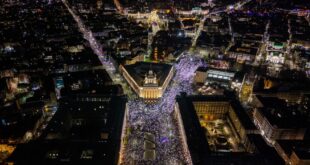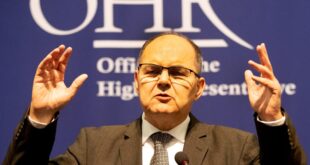 PRISTINAÂ – Kosovo told Serbia on Tuesday it would not yield one inch of its territory, and a violent protest by ethnic Serbs in Bosnia against Kosovo’s secession highlighted continued volatility in the Balkan region.
PRISTINAÂ – Kosovo told Serbia on Tuesday it would not yield one inch of its territory, and a violent protest by ethnic Serbs in Bosnia against Kosovo’s secession highlighted continued volatility in the Balkan region.
Kosovo’s ethnic Albanian Prime Minister Hashim Thaci was responding to a Serbian government pledge to rule Serb-dominated parts of Kosovo following its secession from Serbia 10 days ago.
Hundreds of protesters tried to attack the United States consulate in the Bosnian Serb Republic capital, Banja Luka, after a largely peaceful march by some 10,000 people. They stoned the building before being pushed back by riot police.
The windows of Croat-owned shops in the centre of town were smashed and two policemen were injured in the melee, the latest in a series of violent Serb protests in Belgrade, Novi Sad, Vienna, and northern Kosovo, a Serb stronghold in the new state.
“We understand and respect peaceful reactions, guaranteed by the law, but we will not allow the territorial integrity of Kosovo to be compromised,” Thaci, a former guerrilla commander, said.
“I am constantly in contact with NATO to prevent anyone from touching even one inch of Kosovo’s territory,” he told reporters in Racak, scene of a Serb massacre a decade ago.
Kosovo’s Albanian majority declared independence from Serbia with Western backing on February 17. Serbs in the north reject the secession, fuelling fears that the country is destined for partition, and may trigger a Serb secession from Bosnia.
“As long as we live here we will not recognize an act of violence and secession of Kosovo from Serbia,” Bosnian Serb Prime Minister Milorad Dodik told the Banja Luka rally.
Protest organizer Branislav Dukic, head of a nationalist war veterans’ group pushing for secession, said Bosnia’s Serb republic is “the last line of defense of Serb dignity”. Serbs fear “that every place where the Serbs live will become Kosovo,” he said.
Serbs massacred 44 Albanians in the village of Racak in 1999 before NATO went to war to drive out Serb forces, ending a counter-insurgency war in which 10,000 civilians, overwhelmingly Albanian, were killed .
BIG POWER TURF BATTLE
Kostunica has pledged that Serbian jurisdiction will be upheld wherever “loyal citizens” — not Albanians — look to Belgrade for government. He has promised to keep providing jobs, schooling and infrastructure for Serb areas.
Some 120,000 Serbs remain in Kosovo, just under half in the north in a slice of land that runs adjacent to Serbia and where Serbs seem intent on cutting remaining ties with Pristina.
The United States and major European Union powers have recognized Kosovo, nine years after going to war to save its 90-percent Albanian majority from ethnic cleansing by Serb forces trying to crush a guerrilla insurgency.
Russia is Serbia’s main ally in rejecting Kosovo’s secession, promising political and economic support.
Swift Western recognition sparked days of protests in ethnic Serb areas across the Balkans, in Serbia, northern Kosovo, Montenegro and Bosnia’s autonomous Serb Republic.
NATO’s 16,000-strong peace force has stepped up security in north Kosovo, particularly the flashpoint town of Mitrovica, where Serbs and Albanians are divided by the River Ibar.
The force last week took control of two northern border crossings after they were burned down by Serb mobs.
The EU, which is deploying a 2,000-strong police and justice mission to Kosovo, withdrew its small team from Mitrovica due to security concerns.
 Eurasia Press & News
Eurasia Press & News

